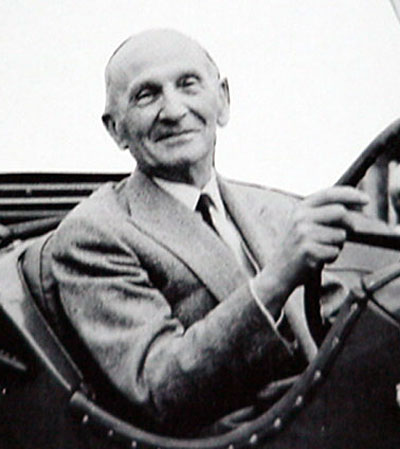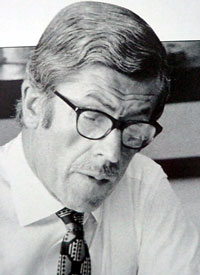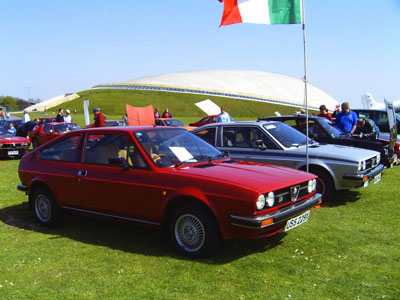Cars don’t build men, men build cars. But while we continually wax lyrical about Alfa Romeos, how many of us recognize the works of Ugo Gobbato, Giorgio Rimini, or Wilfred Ricart?
Fifteen years ago, the late Griff Borgeson took pen in hand to correct this oversight, and with the editors at Automobile Quarterly, set down to write the story of the men of Alfa Romeo. The result was "The Alfa Romeo Tradition", a true sleeper of a book, which on the surface looks like a bargain basement hardback, but between the covers is a treasure of well-researched, valuable information about Alfa’s industrialists and engineers.
Griffith Borgeson was one of the greatest English speaking automotive historians in the second half of the twentieth century. Born in California, he caught the sports car bug shortly after WWII, and began to write articles for a new magazine called Sports Cars Illustrated, and soon was in print in all the major car magazines. Borgeson had the brains of an engineer, and the heart of a biographer. It was a good combination, for he could write well and sympathetically about people as well as engines.
Originally, Borgeson had an interest in hot rods, but being in the LA area, soon was influenced by the strange and exotic cars being brought in by dealers and race car drivers. If we may be allowed an educated guess, it is likely that Borgeson was very impressed by the twin cam engines he saw mounted in Bugattis and Alfa Romeos. They were not the cast iron, inefficient flatheads, L heads and overhead valve engines the hot rodders loved. Rather, what Borgeson saw was a work of art which put out a lot more horses per cubic inch than any production American engine of the era. The facts did not sit well with his generation’s perceptions that America had the greatest cars and designers in the world. What the U.S. did have was the greatest military/industrial propaganda machine in the world.
Borgeson would spend a good deal of the rest of his life researching the history of the twin cam engine. In 1965, Borgeson decided to move to the south of France, where he could more easily continue his investigation into the history of the great cars of Europe.
 Alfa's first
chief engineer, Giuseppe Merosi, in his later years. Photo from
"The Alfa Romeo Tradition". Alfa's first
chief engineer, Giuseppe Merosi, in his later years. Photo from
"The Alfa Romeo Tradition".
|
Borgeson arrived on the scene in Europe just in time to start contributing to a car journal called Automobile Quarterly. Thanks to the contributions of Beverly Rae Kimes, Don Voordeman and Lowell Paddock, AQ quickly established a reputation of being advertising-free and deadly serious about its editorial content. It was automotive history written by automotive historians, and international in scope. Boregeson fit in well, became the European Editor, and contributed fine articles until his death. Ironically, his best work was about the Cord, an American car company.
While living in France, a quick hop away from the major automotive centers in Italy, Borgeson started interviewing old factory workers, accumulating clippings, and getting deep into company archives. By the late 1980s he had enough material for a book on the fascinating men who made the Alfa Romeo.
Borgeson starts from the very beginning, with the remarkable Giuseppe Merosi. Despite his many attempts, he was unable to uncover a great deal of information about Merosi's life, and concludes that Alfa's first great engineer must have been a very private man. He is remember for the sturdy RL series, with a somewhat plain overhead valve six cylinder, but Merosi was capable of much more. In 1913, he designed Alfa’s first twin cam engine, sadly aborted due to the outbreak of WWI in 1914.
A more in-depth look at Nicola Romeo follows. Romeo and his partners profited from war related work, took over the ailing A.L.F.A. company in 1915 and eventually losing control of it by 1928. Romeo was an industrialist, not an engineer, but knew how to promote a product through racing. He added his name to the first post-war cars, thus, Alfa Romeo.
 Vittorio Jano, perhaps the greatest of all Alfa chief engineers. Photo from "The Alfa Romeo Tradition" Vittorio Jano, perhaps the greatest of all Alfa chief engineers. Photo from "The Alfa Romeo Tradition"
|
Nicola Romeo’s right hand man was also a bit of a mystery. Giorgio Rimini is almost just a shadow, but remembered well by Enzo Ferrari. For it was Rimini who directed the automotive sector of Alfa Romeo from 1920 to 1926, and was "probably" responsible for the Merosi RL, the P2, and according to Borgeson, was the man who asked Enzo Ferrari to steal Vittorio Jano from Fiat.
 Rudolf Hruska, one of the most energentic and talented engineer/production managers in the post
war era. Photo from "The Alfa Romeo Tradition". Rudolf Hruska, one of the most energentic and talented engineer/production managers in the post
war era. Photo from "The Alfa Romeo Tradition".
|
Few today remember that Ugo Gobbatto was in control of the company from 1933 to 1945, and despite his close association with Mussolini and the Germans, his abilities and management techniques were unassailable. During those years, the main business of Alfa Romeo was to supply aero engines and military equipment for Mussolini’s growing army and air force. Racing was a sideline, but an important one.
Gobbato succeeded in all respects, but neither he nor Jano was able to stop the well-funded Mercedes Benz and Auto Unions from dominating Grand Prix racing after 1935.
Gobbato replaced Vittorio Jano (who also has a long chapter in the book) with Wilfred Ricart, a Spaniard with a vision. While the cars Ricart conceived were not successes, he gathered together a brilliant team of engineers which would take Alfa to new heights in the postwar era.
Other chapters deal with Gioachino Colombo, Orazio Satta, and finally, Borgeson brings us into the modern era, focusing on Rudolf Hruska. In a long and remarkable career, Hruska, who was born in Vienna, brought Alfa the techniques of mass production with the 1900 series, continued on with the Giulietta, and was responsible for the creation of the 1300 Bertone Sprint, which launched the Giulietta series in 1954. After a stint with Fiat, Hruska returned to Alfa and was led the entire Alfasud project including the construction of the new factory.
 The Alfasud
was Rudolfo Hruska's baby; he alone came up with the concept of the flat four, ront wheel drive Alfa. Photo by Hugh Doran. The Alfasud
was Rudolfo Hruska's baby; he alone came up with the concept of the flat four, ront wheel drive Alfa. Photo by Hugh Doran.
|
Griff Borgeson was at time criticized for inaccuracies stemming from first person interviews with those who had either bad memories or desired to be written of in a better light. While this may be true, his works are important, well-researched and yet at times caused a great deal of controversy. But we would be much poorer without his considerable efforts.